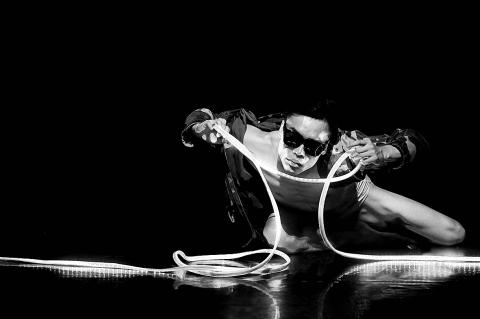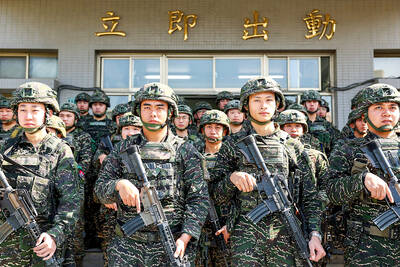The Century Contemporary Dance Company (CCDC, 世紀當代舞團) is hosting its third round Asia collaboration this weekend with Dance in Asia 2018 (2018驅動城市III 混亞洲) at the Huashan 1914 Creative Park in Taipei.
The Taiwanese side of the production features works by several CCDC dancers, including Li Huei-wun (李蕙雯), Liu Jia-rui (劉家瑞) and Mou Tien-yun (莫天昀) as well as Chang Ya-yuan (張雅媛), who has danced with several local troupes and won national awards for previous works, and Lai You-feng (賴有豐).
Artists from the Japanese multi-media art collective off-Nibroll, which presented three sold-out shows of its own version of Dance in Asia 2018 in February in Osaka, Japan, are in Taipei, including Saori Yoneda and Mikuni Yanaihara.

Photo courtesy of Century Contemporary Dance Company
Freelancers Hwang Soo-hyun from South Korea and Huang Chih-hsiung (黃志雄) from Malaysia round out the creative team
The idea behind this year’s project was to bring together artists from four cities —Taipei, Seoul, Tokyo and Kuala Lumpur — to “smash illusions” about the constraints facing Asian bodies, self-identity, family conflicts and the plurality of time, CCDC said.
It also hope that such cross-cultural programs, with Taipei as their center, will inspire ideas for future programs or dances.
There are two different programs: A, which features works, mostly solos, by Mou, Liu, Chang, Yanaihara and Huang; and B, which features works by Mou, Li, Lai, Yoneda and Hwang.
Program A will be performed tonight, tomorrow and Sunday at 7:30pm, while B will be performed at both matinees tomorrow and on Sunday afternoon.
■ Tonight, tomorrow and Sunday at 7:30pm, tomorrow at 2:30pm and 5pm, and Sunday at 2:30pm
■ Huashan 1914 Creative Park (華山1914), 2F Fruit Wine Building (果酒禮堂), 1, Bade Rd Sec 1, Taipei City (台北市八德路一段1號)
■ Tickets are NT$800 or NT$1,500 for special sponsorship seats, available at NTCH box offices, Eslite bookstore ticket desks, online at www.artsticket.com.tw or at convenience store ticket kiosks

That US assistance was a model for Taiwan’s spectacular development success was early recognized by policymakers and analysts. In a report to the US Congress for the fiscal year 1962, former President John F. Kennedy noted Taiwan’s “rapid economic growth,” was “producing a substantial net gain in living.” Kennedy had a stake in Taiwan’s achievements and the US’ official development assistance (ODA) in general: In September 1961, his entreaty to make the 1960s a “decade of development,” and an accompanying proposal for dedicated legislation to this end, had been formalized by congressional passage of the Foreign Assistance Act. Two

President William Lai’s (賴清德) March 13 national security speech marked a turning point. He signaled that the government was finally getting serious about a whole-of-society approach to defending the nation. The presidential office summarized his speech succinctly: “President Lai introduced 17 major strategies to respond to five major national security and united front threats Taiwan now faces: China’s threat to national sovereignty, its threats from infiltration and espionage activities targeting Taiwan’s military, its threats aimed at obscuring the national identity of the people of Taiwan, its threats from united front infiltration into Taiwanese society through cross-strait exchanges, and its threats from

Despite the intense sunshine, we were hardly breaking a sweat as we cruised along the flat, dedicated bike lane, well protected from the heat by a canopy of trees. The electric assist on the bikes likely made a difference, too. Far removed from the bustle and noise of the Taichung traffic, we admired the serene rural scenery, making our way over rivers, alongside rice paddies and through pear orchards. Our route for the day covered two bike paths that connect in Fengyuan District (豐原) and are best done together. The Hou-Feng Bike Path (后豐鐵馬道) runs southward from Houli District (后里) while the

March 31 to April 6 On May 13, 1950, National Taiwan University Hospital otolaryngologist Su You-peng (蘇友鵬) was summoned to the director’s office. He thought someone had complained about him practicing the violin at night, but when he entered the room, he knew something was terribly wrong. He saw several burly men who appeared to be government secret agents, and three other resident doctors: internist Hsu Chiang (許強), dermatologist Hu Pao-chen (胡寶珍) and ophthalmologist Hu Hsin-lin (胡鑫麟). They were handcuffed, herded onto two jeeps and taken to the Secrecy Bureau (保密局) for questioning. Su was still in his doctor’s robes at